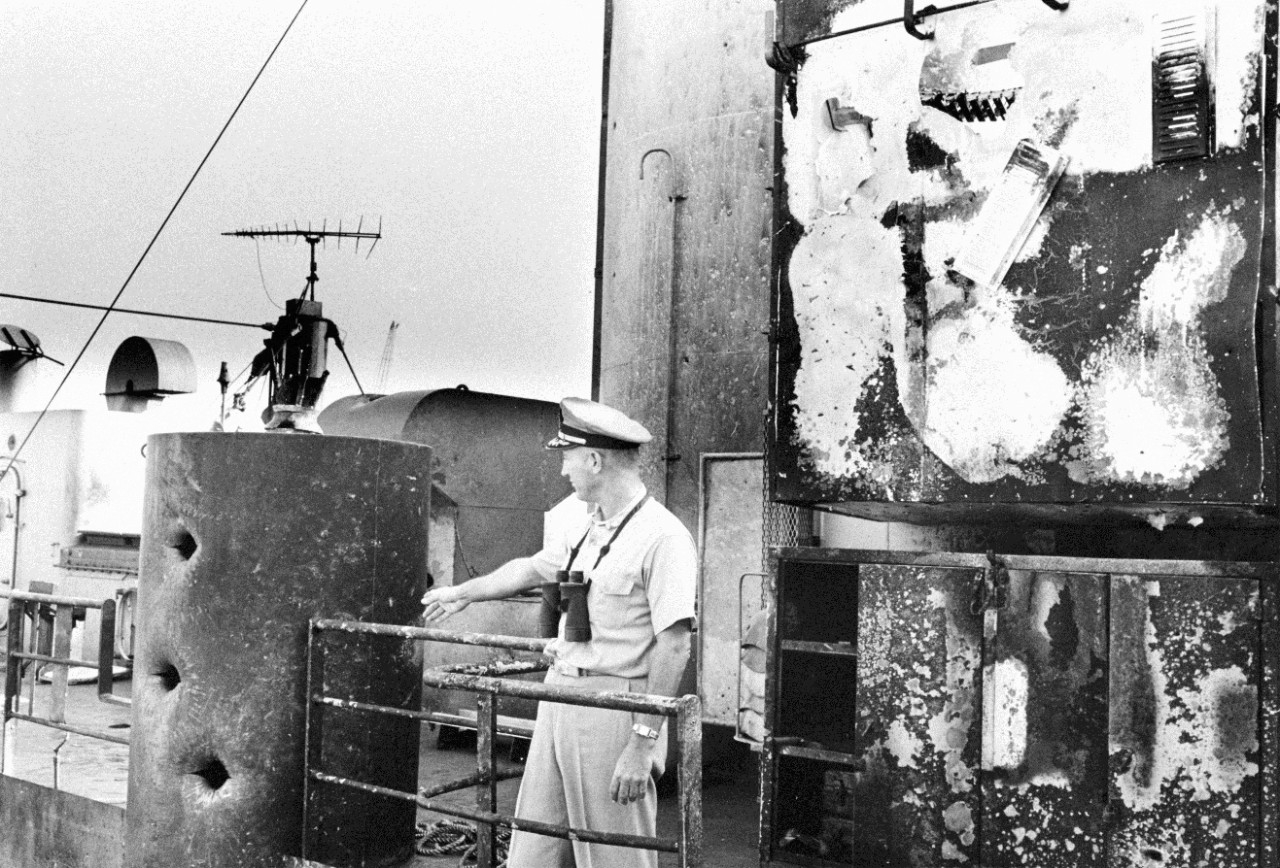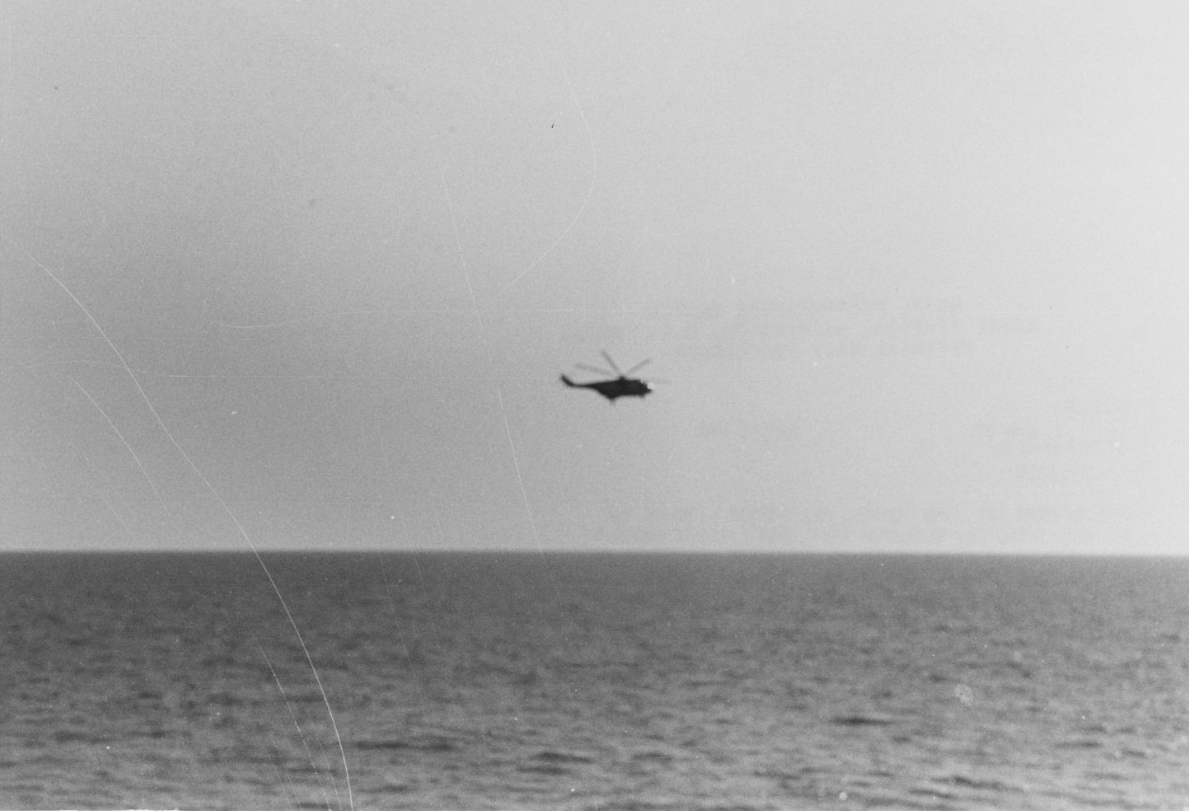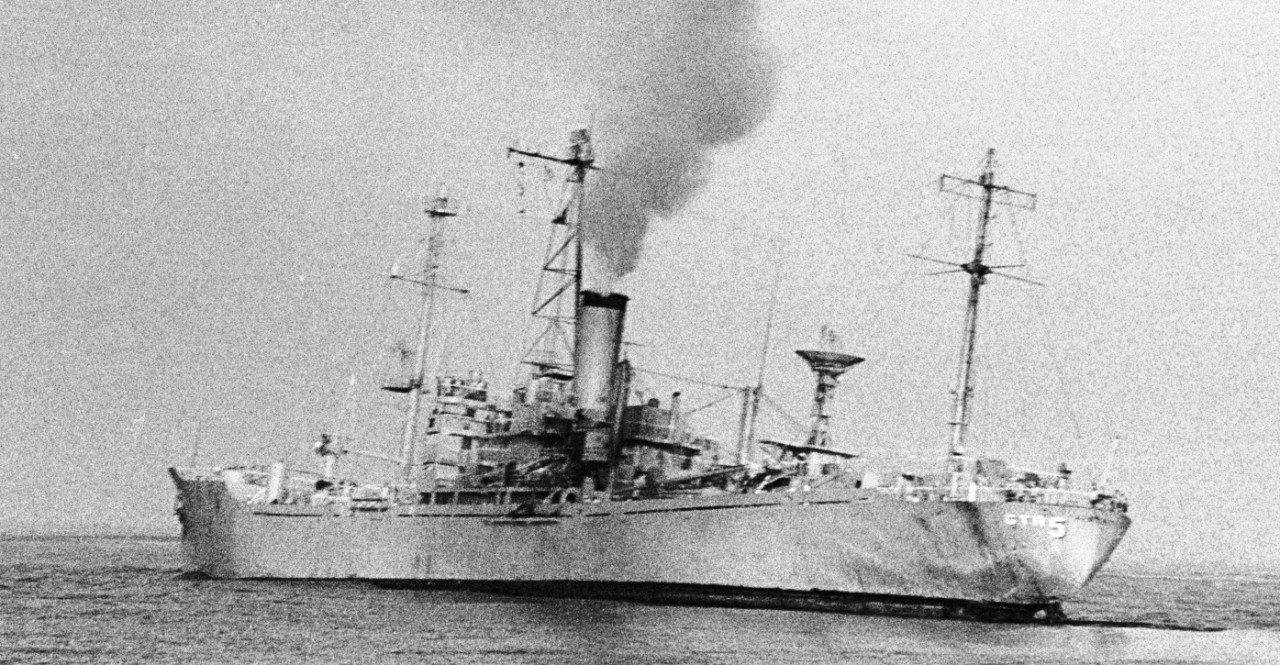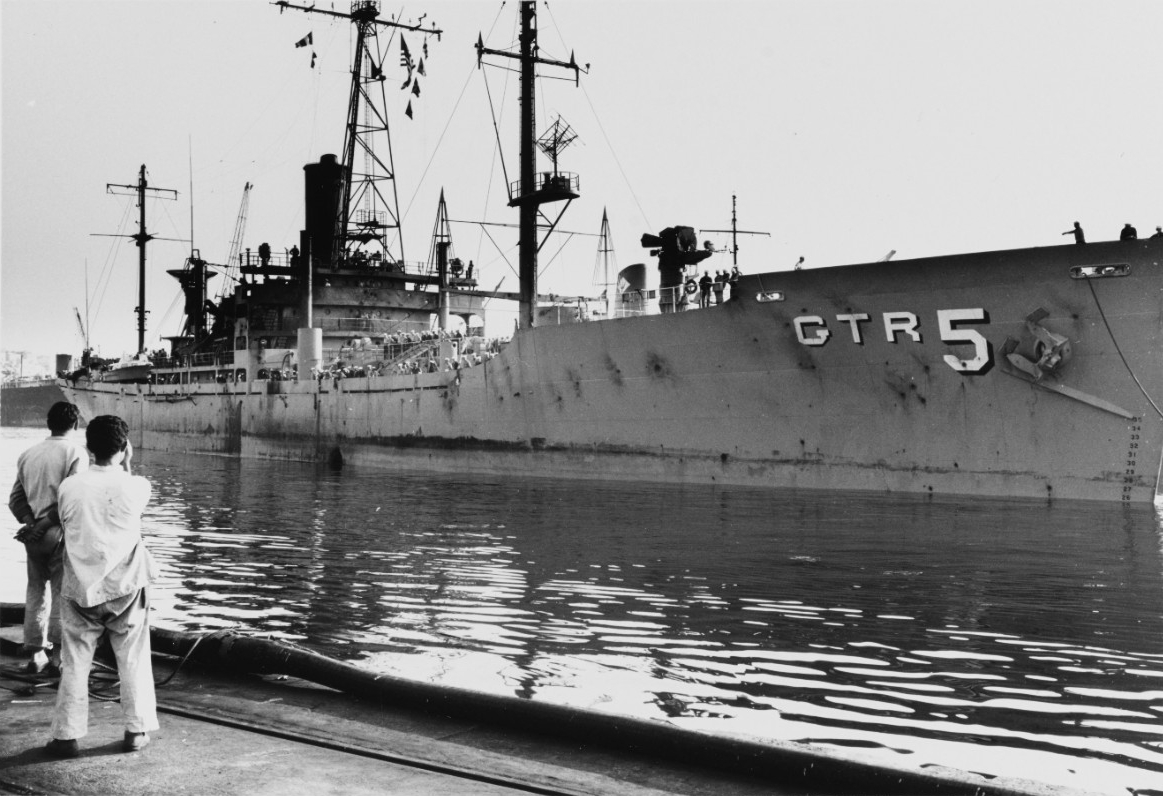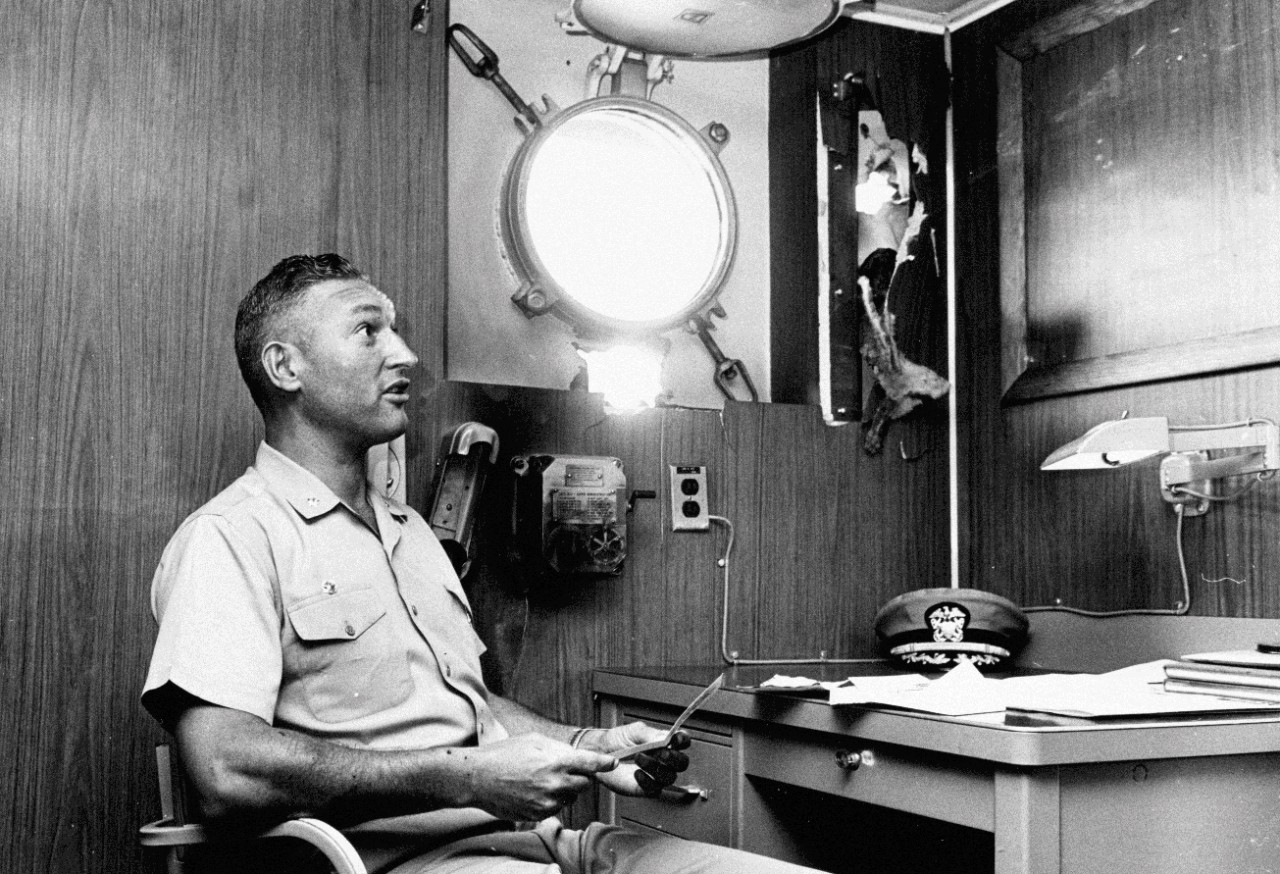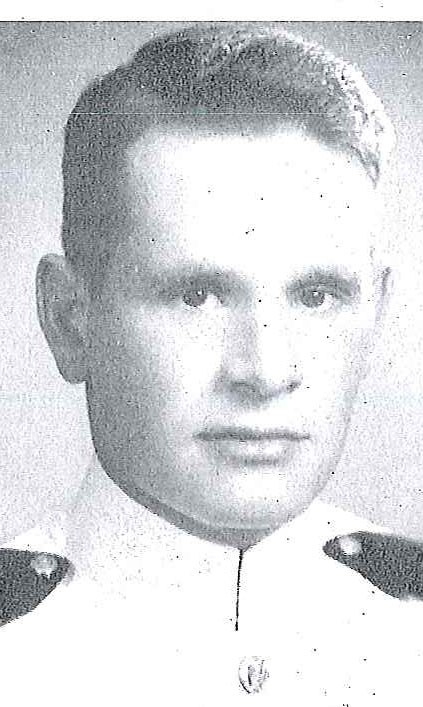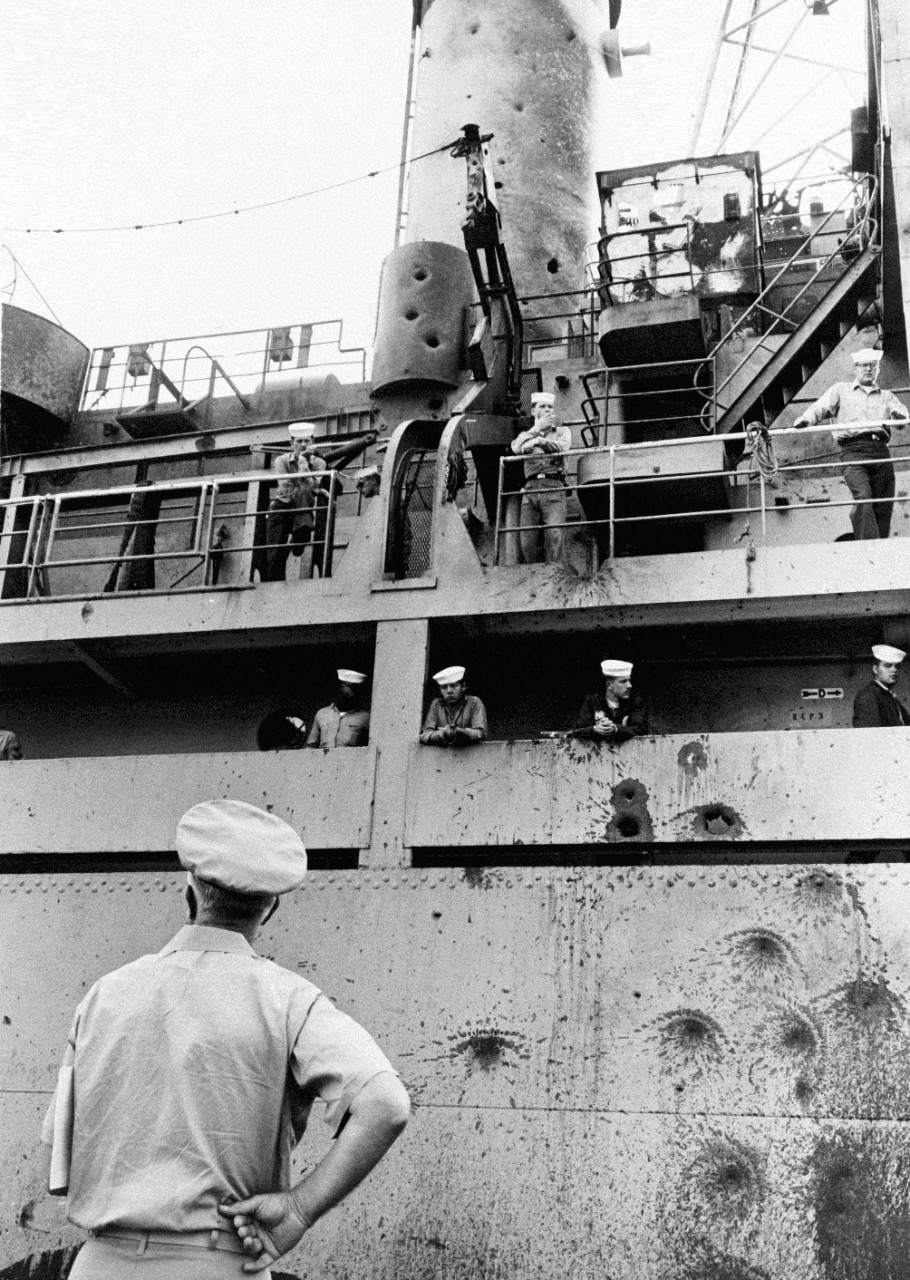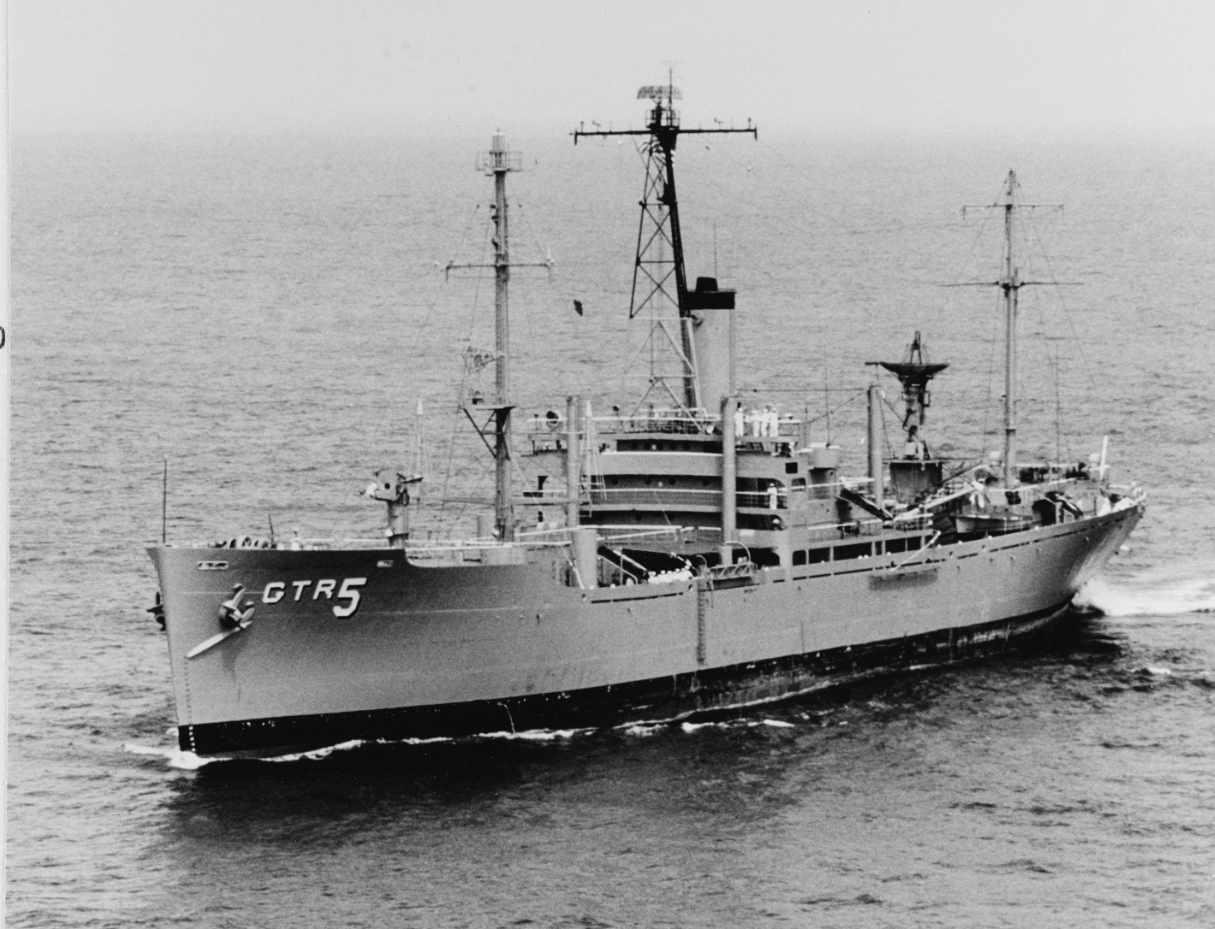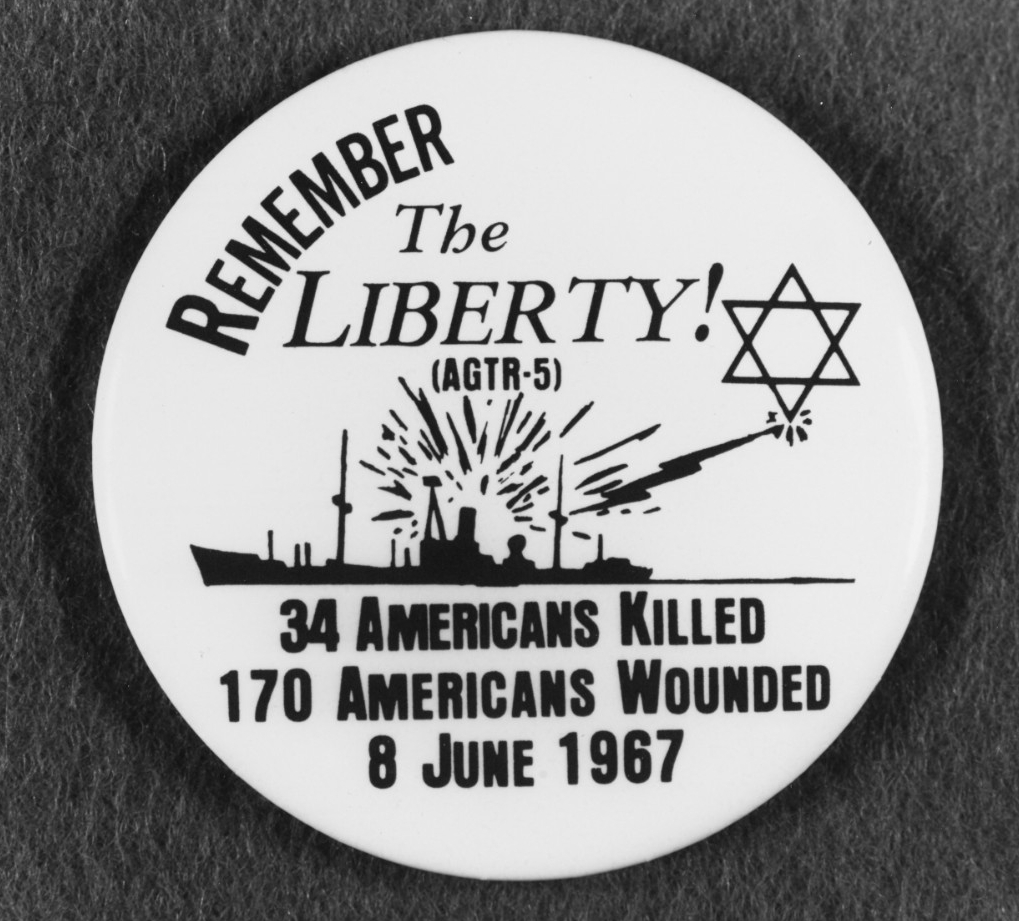The Arab-Israeli “Six-Day War” and the Attack on USS Liberty (AGTR-5)
June 1967
USS Liberty (AGTR-5) with a starboard list following the 8 June 1967 attack by Israeli forces during the Arab-Israeli “Six-Day War.” The ship was accompanied by USS Little Rock (CLG-4) as it slowly limped toward Valletta, Malta, for temporary repairs. The helicopter hovering over the bow of the ship was transporting casualties. (USN 1123118)
In June 1967, in response to escalating Arab-Israeli hostilities, USS Liberty (AGTR-5) was operating in the Mediterranean in international waters conducting an intelligence collection mission. Sixth Fleet had received orders in late May to move into the region in response to the withdrawal of the United Nations Emergency Force from Sinai. While operating off the north coast of the Sinai Peninsula on the afternoon of 8 June, in the midst of the Arab-Israeli “Six-Day War” (5–10 June 1967), Liberty was attacked with multiple strafing runs by two unidentified jet fighters—presumed to be Israeli. Twenty minutes later, after first circling Liberty, three motor torpedo boats from Israeli MTB Division 914 closed in at high speeds and launched five torpedoes, of which one, fired from T-203, hit the ship and exploded between frames 53 to 66, tearing a tear-drop shaped hole in the starboard side, 39 feet across at its widest point. Twenty members of Liberty’s crew were killed instantly. Of the 293 U.S. personnel on board the ship, 34 (31 Sailors, two Marines, and one National Security Agency civilian) were killed and another 170 wounded. In the immediate aftermath, Israel did apologize, expressed deep regret, and offered assistance (Liberty refused due to the sensitive nature of its mission), but debates continue about whether the Israeli attack was premeditated or a tragic accident resulting from negligent mistakes or the fog of war. To this date, no evidence has ever surfaced that the Israelis deliberately attacked what they knew to be an American ship. After the attack, Liberty departed the area and slowly made way to Valetta, Malta, for temporary repairs, before continuing on to Naval Amphibious Base, Little Creek, Virginia, for more extensive repairs. After the ship was deemed “prohibitively costly” to repair, Liberty was stricken from the Naval Vessel Register on 1 June 1970 and later sold for scrap.
Liberty was subsequently awarded the Presidential Unit Citation and the Combat Action Ribbon. As Admiral John S. McCain, Jr., later wrote, “Heroism was the order of the day.” Lieutenant Commander Philip Armstrong Jr., executive officer of Liberty, was awarded the Navy Cross (posthumously). Silver Star Medals were awarded to 11 crewmembers (two posthumously), and 19 were awarded the Bronze Star Medal. Commander William L. McGonagle, in a ceremony at the Washington Navy Yard on 11 June 1968, was awarded the Medal of Honor in recognition of his “superb professionalism, courageous fighting spirit, and valiant leadership.”
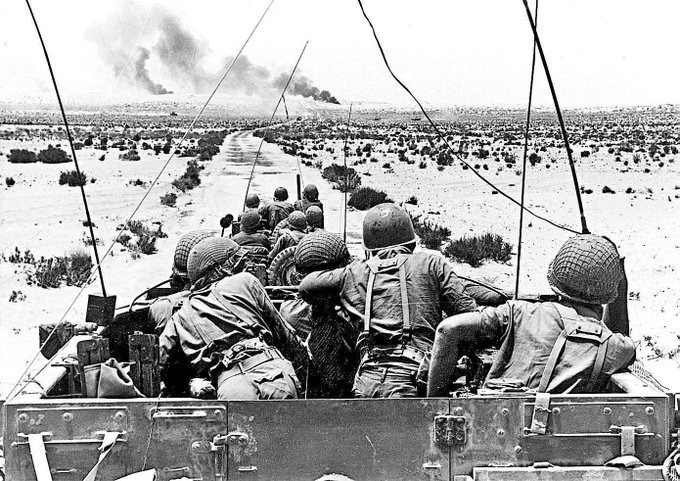
On 5 June 1967, Israel, surrounded and fearing an imminent Arab attack, launched preemptive attacks against the Egyptian army in the Sinai during the Arab-Israeli “Six-Day War.” Within three days, Israeli forces had captured the Gaza Strip and all of the Sinai Peninsula up to the east bank of the Suez Canal. (Official Israeli Defense Forces photograph)
The "Six-Day War"
By late 1966, attacks against Israel by Palestinian guerrilla groups based in Syria, Lebanon, and Jordan had increased exponentially, leading to retaliatory strikes by the Israeli military. In November 1966, an Israeli assault on the village of Al-Samū in the Jordanian West Bank left 18 dead and 54 wounded. During an air battle with Syria in April 1967, the Israeli air force shot down six Syrian MiG fighter jets. In May, Soviet intelligence further heightened tensions in the region when it reported, although inaccurately, that Israel was planning a campaign against Syria. Egyptian President Gamal Abdel Nasser was subjected to sharp criticism for his perceived failure to aid Syria and Jordan against Israel. He was accused of hiding behind UN forces stationed at Egypt’s border with Israel in the Sinai Peninsula. On 14 May, in an effort to demonstrate his support for Syria to his critics, Nasser mobilized and sent a 100,000-man strong Egyptian force to the Sinai. Four days later, he formally requested the removal of UN forces there. On 23 May, he closed the Straits of Tiran to Israeli shipping, thus forming a blockade of the Gulf of Aqaba off the Israeli port of Eilat. On 30 May, King Hussein of Jordan arrived in Cairo, where he signed a mutual defense pact with Egypt, placing Jordanian forces under overall Egyptian command.
On 5 June, Israel, fearing an imminent combined attack by its Arab neighbors, launched preemptive strikes that destroyed 90 percent of Egypt’s air force on the tarmac. That day, a similar air attack incapacitated the Syrian air force. Without cover from the air, the Egyptian army was vulnerable, and within three days, Israeli forces had captured the Gaza Strip and all of the Sinai Peninsula up to the east bank of the Suez Canal. On Israel's eastern border, Jordanian forces began to shell Western Jerusalem, defying Israel’s warning to keep out of the fight. In retaliation, Israel mounted a crushing counterattack, and by 7 June, Israeli forces had driven the Jordanian military out of East Jerusalem and most of the West Bank. Later that day, the UN Security Council called for a cease-fire, and it was immediately accepted by Israel and Jordan. Egypt accepted the cease-fire the following day. However, Syria held out and continued to shell villages in northern Israel. On 9 June, Israel launched an assault on the fortified Golan Heights, overlooking the upper Jordan River. After a day of heavy fighting, Israeli forces captured the area. On 10 June, Syria accepted the cease-fire.
The Six-Day War was disastrous for the Arab countries—Egypt suffered 11,000 casualties, Jordan 6,000, and Syria 1,000. In comparison, the Israeli army lost 776 soldiers. In addition, the Arab armed forces were crippled by massive losses of weaponry, equipment, and aircraft. The lopsided defeat demoralized the Arab public and political elite, while solidifying Israel as the region’s preeminent military fighting force. In the aftermath of the conflict, hundreds of thousands of refugees were created, bringing more than one million Palestinians into the occupied territories under Israeli rule. In November, the Security Council unanimously adopted Resolution 242, calling for peace and recognition of the “right of every nation to live free from threat within secure and recognized boundaries,” in return for Israel’s withdrawal “from territories,” not “all the territories,” nor “the territories captured in the course of the recent hostilities.” The resolution prompted diplomatic efforts between Israel and its neighbors, including the long-sought Camp David Accords in the late 1970s.
Timeline: Attack on USS Liberty
Date—Local Military Time
- 2 June 1967: Liberty departed Rota, Spain, en route to a position north of the Egyptian/United Arab Republic (UAR) coast (32–00N, 33–00E). It was ordered to remain 12.5 miles from the Egyptian coast and 6.5 miles from the Israeli coast.
- 8 June—0250: Commander, U.S. Navy Europe’s (CINCUSNAVEUR) duty officer received phone instructions from the Joint Reconnaissance Center directing Liberty to comply with Commander, Sixth Fleet’s (COMSIXTHFLEET) 100-mile operating area restriction.
- 8 June—0950: Liberty was circled by two unidentified delta-wing single-engine jet fighters, presumably Israeli Mirages.
- 8 June—1217: COMSIXTHFLEET ordered Liberty at least 100 miles away from coast of UAR and Israel and 25 miles from Cyprus. This message apparently not received by Liberty prior to Israeli attack.
- 8 June—1505: Liberty was attacked by unidentified jet fighters, which made six strafing runs. The ship was 25 miles northeast of the nearest land (31–35.5N, 33–29.0E).
- 8 June—1525: Three torpedo boats, one identified as Israeli, approached the ship. One boat bore the hull number 206–T.
- 8 June—1527: Liberty fired at a torpedo boat at a range of 2,000 yards.
- 8 June—1528: Liberty was hit by torpedo. The torpedo boats cleared to the east about five miles.
- 8 June—1530: COMSIXTHFLEET reported Liberty hit by torpedo (31–23N, 33–25E). Three unidentified gunboats approached.
- 8 June—1531: Hatzor air control (near Tel Aviv) told helicopters (two) to try to rescue men who had jumped into the water from “warship which we attacked.”
- 8 June—1534: Israeli helicopter identified ship as “definitely Egyptian.” Helicopters ordered back to base.
- 8 June—1539: Hatzor air control told helicopter to rescue men.
- 8 June—1550: COMSIXTHFLEET ordered carriers to provide air cover for Liberty.
- 8 June—1552: Liberty reported under attack to COMSIXTHFLEET.
- 8 June—1555: Liberty reported hit by torpedo starboard side. Two Israeli helicopters circled ship at range of 500 yards. Israeli torpedo boats offered assistance, which was refused.
- 8 June—1559: Liberty still under air attack. Hatzor air control told helicopter to clarify the nationality of the first man it recovered.
- 8 June—1602: Helicopter reported (to Haztor) a big ship and three small ships about a mile from the helicopter. (This placed the torpedo boats about eight miles from Liberty.)
- 8 June—1607: Hatzor told helicopters if men were Egyptians, to take them to El Arish; if they spoke English and were not Egyptians, to take them to Lydda.
- 8 June—1610: Haztor told helicopter again to clarify nationality. (It appears from the obvious importance of this questions that the Israelis suspected they may have hit an American or British and not an Egyptian ship.) Hull number of Liberty seen by Israeli helicopter pilot, who did not recognize significance.
- 8 June—1612: Hatzor asked helicopter, “Did it clearly signal an American flag?” Later, requested helicopter to make another pass and check again whether it was really an American flag.
- 8 June—1616: Hatzor ordered helicopters to return to El Arish.
- 8 June—1714: Tel Aviv reported Israeli aircraft and patrol boats attacked ship at 1500 (0800 Washington time) at position 31–25N, 33–33E. Suspecting a U.S. ship, Israel offered to render assistance and expressed deep regret.
- 8 June—1804: The U.S. defense attache in Tel Aviv reported that Israeli helicopters and the three torpedo boats searched the area until 1804. The Israeli offer of assistance was declined because of the sensitive mission of the ship. COMSIXTHFLEET recalled the aircraft launched from carriers USS America (CVA-66) and USS Saratoga (CV-60), and sent two destroyers, USS Davis (DD-937) and USS Massey (DD-778), to assist Liberty. Liberty proceeded northwest at eight knots. There was no further contact between Liberty and Israeli forces. Two Soviet ships trailed Liberty, which proceeded under escort to Malta.
*Source: U.S. State Department
*****
Suggested Reading
- H-Gram 007: USS Liberty
- Logbook USS Liberty (AGTR-5), June 1967
- Logbook USS Liberty (AGTR-5), July 1967
- U.S. State Department: Foreign Relations, 1964–68, Arab-Israeli Crisis
- National Security Agency: Declassified Reports (FOIA) of USS Liberty (AGTR-5) Attack
- The U.S. Navy in the Cold War Era, 1945–1991
- Use of Naval Forces in the Post-War Era
- IWTC Corry Station Remembers USS Liberty


